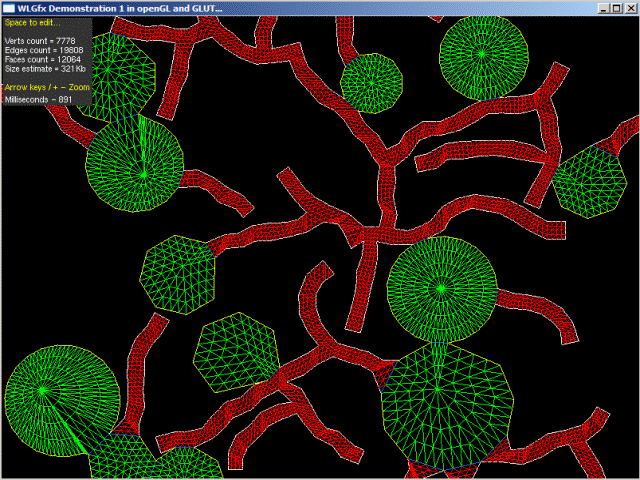Although I've moved over to raw openGL I've not stopped working on this project.
TESSELLATION is the latest thing I've added to the level generation. This is so that the floor of the dungeon will appear so much smoother when this finally gets used in a game I want to eventually work on. Distance culling will also be added as each segment can be checked with distance from the camera and only the closer segments will get there openGL display list called.
Next step is to view the 3D model and make sure the calculations for the vertex normals work okay...
This screen shot shows 2 levels of tessellation of a 50 segment dungeon which takes up only 321kb to upload to the GPU as a vertex buffer object:

The source code for the tessellation function:
void PROC_MAP::tessellate(int levels)
{
while ( levels ) {
// go through every face and tessellate it
// it will also keep a temp record of the edges split and the new vert for the mid point
int size = edges.size();
int esize = size; // original size of the temp edges list
_temp_edge_list *edge_list = new _temp_edge_list[ size ];
int v1, v2;
float temp_vert_x, temp_vert_y, temp_vert_z;
int vpos = verts.size(); // this is the new vert position
while ( size ) {
size--;
v1 = edges[ size ].v1;
v2 = edges[ size ].v2;
// get the midpoint
temp_vert_x = ( verts[ v1 ].x + verts[ v2 ].x ) / 2.0f;
temp_vert_z = ( verts[ v1 ].z + verts[ v2 ].z ) / 2.0f;
// get new noise height for the y coord
temp_vert_y = get_noise(temp_vert_x, temp_vert_z);
// store the new vert now
verts.push_back( _VERT(temp_vert_x, temp_vert_y, temp_vert_z) );
// change the current edges second vert
edges[ size ].v2 = vpos;
// add new edge
edges.push_back( _EDGE(vpos, v2, edges[ size ].type, edges[ size ].segment) );
//edges.push_back( _EDGE(vpos, v2, 0, edges[ size ].segment) );
// add the details of the original edge to the struct
edge_list[ size ].v1 = v1;
edge_list[ size ].v2 = v2;
edge_list[ size ].mid_vert = vpos;
// increment the vpos for the next vert position mid point
vpos++;
}
// now re-create the faces list
size = faces.size();
int v3, edge1, edge2, edge3;
int mid1, mid2, mid3;
int type, segment, etype;
while ( size ) {
size--;
// store the faces original vertex indices for adding the new faces later
v1 = faces[ size ].v1;
v2 = faces[ size ].v2;
v3 = faces[ size ].v3;
// and the type and segment info
type = faces[ size ].type;
segment = faces[ size ].segment;
// problem here:
// I've stored the vertex index for the face instead of the edge index
// so I'll have to find the original edge that matches both vertex indices
// Luckily enough I've stored the info in the temp_edges list
edge1 = find_temp_edge(v1, v2, edge_list, esize);
edge2 = find_temp_edge(v2, v3, edge_list, esize);
edge3 = find_temp_edge(v3, v1, edge_list, esize);
mid1 = edge_list[ edge1 ].mid_vert;
mid2 = edge_list[ edge2 ].mid_vert;
mid3 = edge_list[ edge3 ].mid_vert;
// alter original face first to new midpoints
faces[ size ].v2 = mid1;
faces[ size ].v3 = mid3;
// now add the new faces
faces.push_back( _FACE(mid1, v2, mid2, type, segment) );
faces.push_back( _FACE(mid3, mid2, v3, type, segment) );
faces.push_back( _FACE(mid1, mid2, mid3, type, segment) ); // centre face
// set new new edges type for inner edges
if ( type == PM_CFACE ) etype = PM_CINNER;
else etype = PM_RINNER;
// now add the centre faces edges to the edge_list
edges.push_back( _EDGE(mid1, mid2, etype, segment) );
edges.push_back( _EDGE(mid2, mid3, etype, segment) );
edges.push_back( _EDGE(mid3, mid1, etype, segment) );
}
// remove the temp edge list
delete[] edge_list;
levels--;
} // eof while ( levels )
}
int PROC_MAP::find_temp_edge(int v1, int v2, _temp_edge_list *list, int size)
{
int pos = 0;
while ( pos < size ) {
if ( v1 == list->v1 && v2 == list->v2 ) return pos;
if ( v1 == list->v2 && v2 == list->v1 ) return pos; // double checking
pos++;
list++;
}
return 0; // It really should not get to this point
}Mental arithmetic? Me? (That's for computers) I can't subtract a fart from a plate of beans!
Warning! May contain Nuts!